To level resin-bound gravel on uneven ground, begin with a thorough site assessment. Check the ground levels, drainage patterns, and soil stability. Use suitable leveling compounds, such as Ardex K301, to achieve a smooth finish. Aim for a layer thickness of 18mm on driveways and 15mm on footpaths, using self-levelling compounds to fill dips. Implement effective drainage solutions and ensure conditions are dry during installation. With proper preparation, you can create a durable surface. For additional tips to enhance your project, explore further techniques.
Key Takeaways
- Start with a site assessment to check ground levels, drainage, and soil stability before laying resin-bound gravel.
- Use self-levelling compounds to fill in dips and ensure a smooth surface for the resin-bound system.
- Make sure the sub-base is at least 18mm deep for driveways and 15mm for footpaths to adequately support the gravel.
- Employ depth gauges or screed rails to keep the thickness consistent within ±2mm across the installation.
- Install drainage systems to effectively manage water, and aim to work on dry days when temperatures exceed 10°C for the best results.
Site Assessment and Ground Preparation
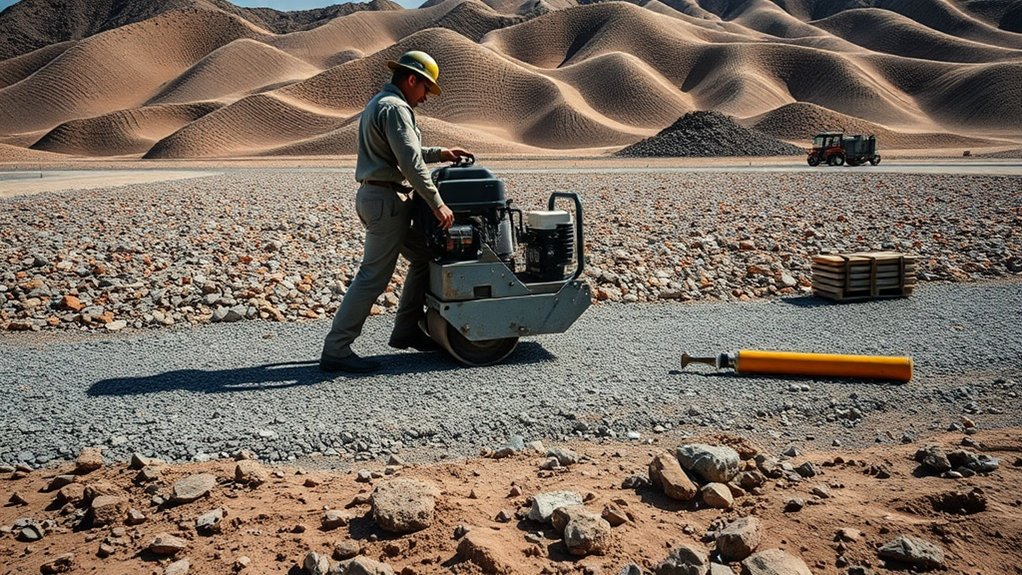
Before installing resin-bound gravel, it’s essential to carry out a thorough site assessment and prepare the ground properly to ensure long-lasting results.
Begin with a detailed evaluation of the site to check the ground levels and slopes, aiming for an ideal gradient of 1:12 to 1:40.
Examine the drainage patterns to spot any potential issues that could lead to water pooling, including ensuring compliance with SUDS regulations.
Assess the soil stability to ensure it can support the resin-bound system.
Remove any debris or existing materials to create a clean surface.
If necessary, reinforce the base for added strength.
Lastly, establish proper drainage channels to manage water effectively.
This careful groundwork is crucial for a durable and high-performing resin-bound gravel surface, ready to withstand the UK’s varied weather conditions, as resin-bound gravel is known for its excellent water drainage capabilities.
Leveling Techniques for Uneven Ground
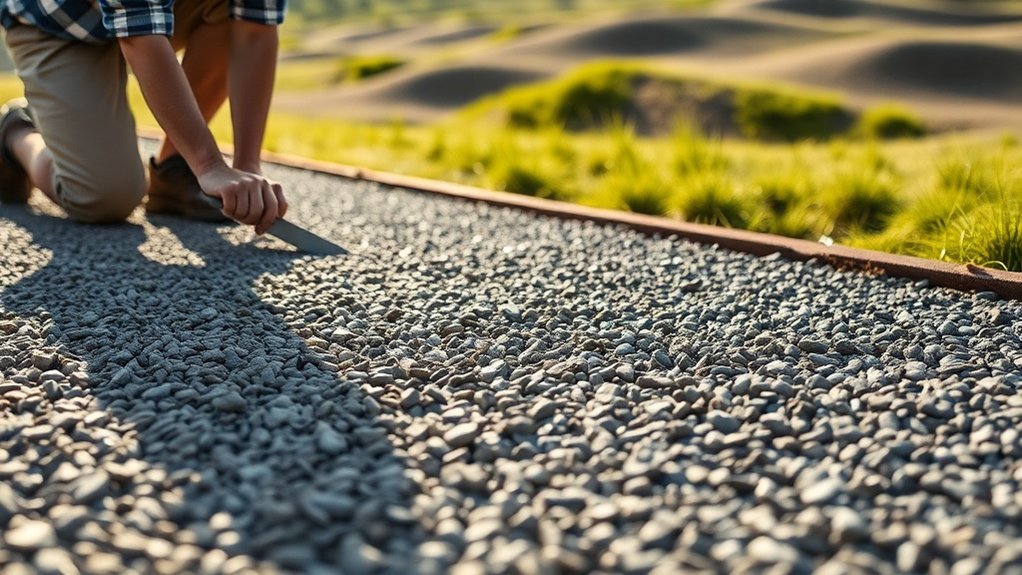
When levelling uneven ground, it’s crucial to choose the right levelling compounds for a smooth finish. It’s important to monitor the layer thickness to ensure good adhesion and performance of the resin-bound gravel. For instance, using a self-levelling compound can help fill in dips effectively. Additionally, removing sod before applying the levelling compound can significantly enhance the stability of the foundation. Proper sub-base preparation is essential to maintain an even surface above it.
Suitable Leveling Compounds
To achieve a smooth and level surface for your resin-bound gravel installation, it’s crucial to choose the right leveling compound. Ardex K301 is a solid option, though it can be pricey; it performs well in outdoor applications. Additionally, ensure that the concrete or tarmac base is strong enough for the intended use. The chosen sub-base should be prepared with a depth that ensures stability and drainage, as proper sub-base preparation is essential for long-lasting results. Epoxy resin compounds are versatile and suitable for priming and filling any imperfections. Cempolay Ultra and Flow Top are reliable choices for preparing surfaces, especially outdoors. For uneven areas, Site Mix Granolithic Concrete provides a strong solution. When considering costs, balance the benefits of durability with the initial expenditure. Each compound has distinct properties that influence performance, so ensure your choice matches the specific challenges of your site for the best results.
Layer Thickness Control
Achieving the correct layer thickness is crucial for a successful resin-bound gravel installation, particularly on uneven surfaces. Consistent depth measurement ensures durability and prevents cracking. Here are the guidelines for ideal aggregate selection and thickness control:
| Layer Type | Recommended Thickness |
|---|---|
| Driveways | At least 18mm |
| Footpaths | Minimum 15mm |
| Unstable Areas | 30–40mm |
| Standard Aggregate | 18mm (3x aggregate) |
| Risks of Thin Layers | Cracking, failure |
Use depth gauges or screed rails during installation to maintain uniformity within ±2mm. Address ground irregularities by filling low spots and smoothing out high areas. Ensuring proper layer thickness not only boosts strength but also enhances overall performance and longevity.
Handling Slopes and Gradients
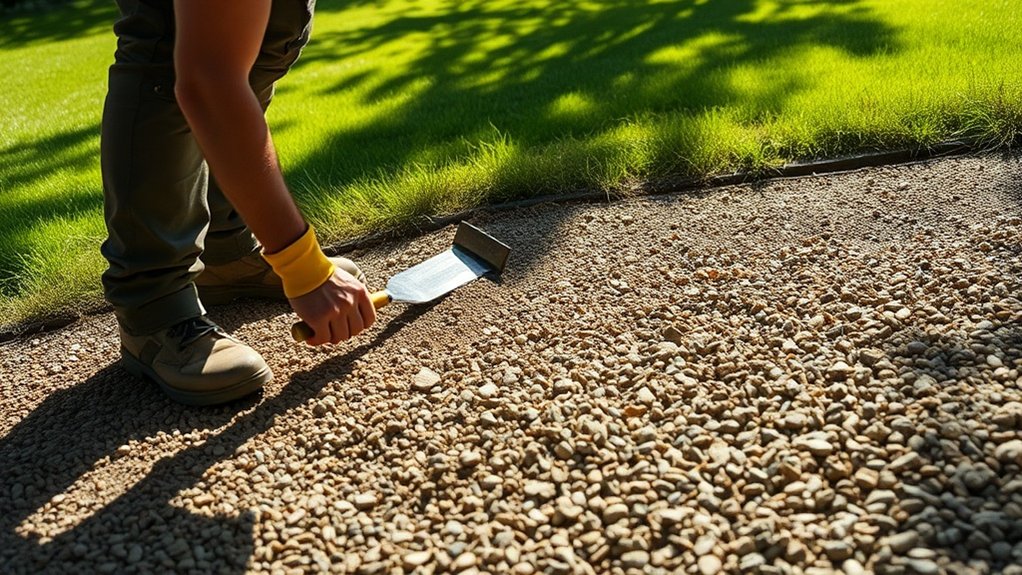
Successfully managing slopes and gradients during resin-bound gravel installation requires careful attention to the terrain.
To ensure slope stability and proper gradient assessment, follow these steps:
- Inspect and Prepare: Check for cracks and weak areas to ensure a level base for drainage. Clear away any debris or vegetation to enhance resin adhesion.
- Apply Strategically: Begin at the bottom of the slope and work your way up, tackling small sections at a time to maintain control and prevent slippage.
- Enhance Safety: Use anti-slip additives, particularly on steeper gradients, to boost traction and minimise the risk of accidents.
Resin Mixing and Application
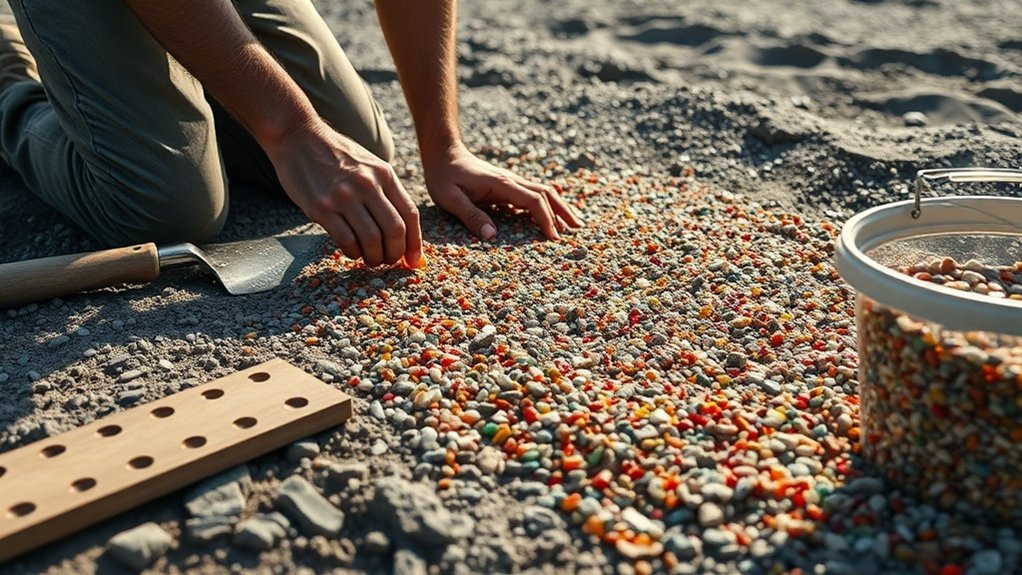
When mixing resin for your gravel application, precision is crucial for a strong and attractive finish.
Start with a two-part resin binder, measuring Part A and Part B accurately for consistent curing. Use a paddle mixer to blend until the resin turns a lighter shade, indicating it’s ready.
Add your aggregates gradually, starting with a portion to help distribute them evenly. Introduce the mixed resin slowly, ensuring all stones are coated evenly. Add fines towards the end to enhance adhesion.
Use a stopwatch to maintain consistent mixing times and avoid colour variation.
Lastly, ensure you work in suitable environmental conditions and wear protective gear. Keep your workspace dry and clean throughout the process for the best results.
Drainage Integration and Weather Considerations
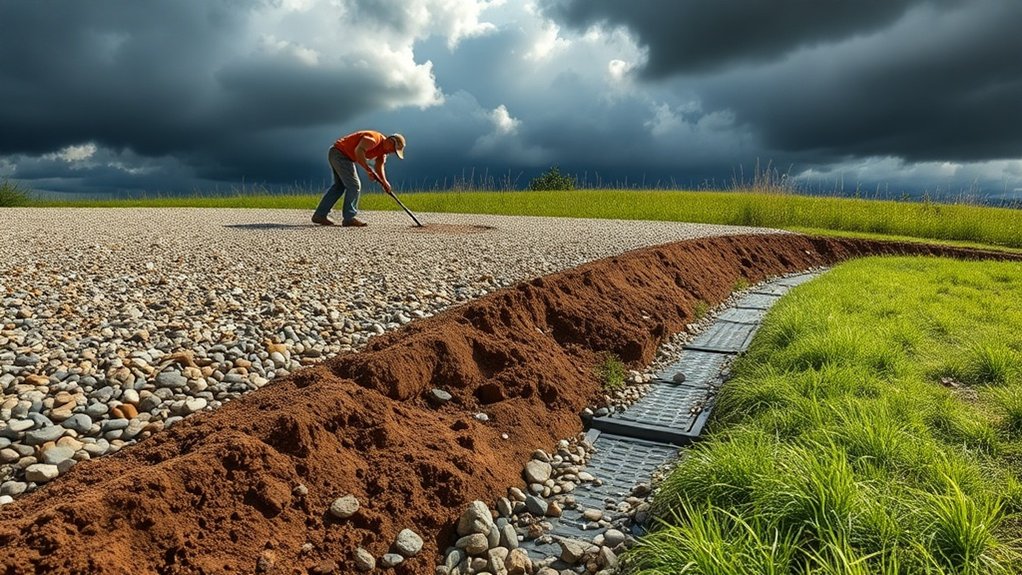
When planning your resin-bound gravel installation, effective drainage is crucial for long-lasting performance, particularly on uneven surfaces.
Here are three key points to enhance drainage efficiency:
- Sub-Base Preparation: Opt for a permeable MOT Type 3 aggregate base, which should be graded to direct water towards drainage points, helping to prevent pooling.
- Channel Drainage Systems: Install interlocking channels to guide water away from your installation, protecting it from flooding during heavy rainfall.
- Weather Considerations: Schedule the installation on dry days with temperatures above 10°C to ensure proper curing and adhesion, avoiding issues caused by unexpected rain.
Complex Situations: Manholes and Edging
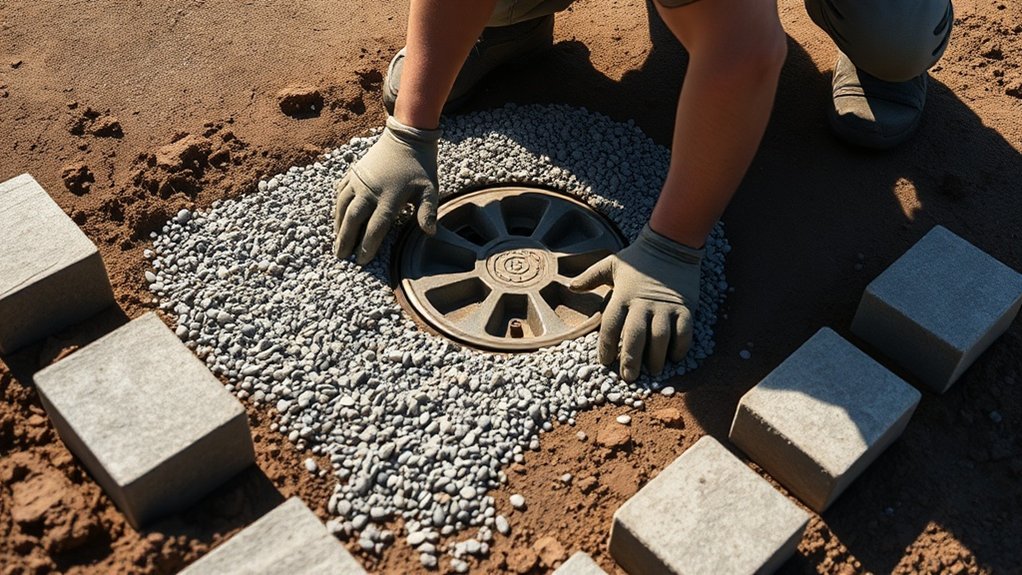
Effective drainage is crucial when dealing with complex situations like manholes and edging. When installing manholes, ensure there’s a solid, level cement base for recessed lids to guarantee stability and easy access.
Use resin-bound aggregates that either blend in with or contrast the surrounding paving for a pleasing look. For edging, choose robust materials that complement the resin-bound surface. Secure them properly to prevent any shifting and align them to avoid trip hazards.
Also, remember to leave gaps for thermal expansion to maintain the structure’s integrity. Smooth transitions between manholes and edging help prevent water pooling and enhance safety.
Regular inspections are essential to identify any wear or misalignment, ensuring your resin-bound installation remains functional and visually appealing.
Frequently Asked Questions
How Long Does Resin-Bound Gravel Typically Last?
Resin-bound gravel usually lasts between 15 to 25 years, depending on factors like the quality of materials and maintenance. With proper care, you could see it last even longer, possibly up to 30 years. For instance, regular cleaning and avoiding heavy traffic can help maintain its appearance and durability.
Can Resin-Bound Gravel Be Installed in Freezing Temperatures?
No, you shouldn’t install resin-bound gravel in freezing temperatures. Cold conditions can slow down the curing process, leading to potential cracks and poor adhesion, which can undermine the durability and performance of the surface. It’s best to wait for more suitable weather to ensure a long-lasting finish.
What Maintenance Is Required After Installation?
After installation, regular care for your resin-bound gravel is essential. To maintain its appearance and performance, simply sweep the surface regularly, hose it down to remove dirt, and keep weeds at bay. It’s also wise to check for any stains or debris now and then to ensure its longevity. With these straightforward practices, you can keep your resin surface looking great for years to come.
Is Resin-Bound Gravel Suitable for Driveways?
Yes, resin-bound gravel can turn your driveway into an attractive feature while providing excellent durability. Its permeable design allows for effective drainage, helping to keep your driveway looking good and functional, even with light vehicle use.
How Do I Choose the Right Aggregate Color?
To select the right aggregate colour, think about the style of your home and its surroundings. Look at various aggregate colour options, ensuring they either complement or contrast nicely with features such as brickwork, windows, and landscaping. For example, if you have red brick, a neutral aggregate could provide a pleasing balance. Aim for a cohesive look that enhances your property’s appeal.
Conclusion
Leveling resin-bound gravel on uneven ground can turn a disordered surface into a smooth pathway. It’s not just about fixing imperfections; it’s about creating a durable landscape that combines visual appeal with practicality. When working on slopes and difficult areas, remember that each technique you use will improve both stability and the overall look of your project. Embrace the task, and let your creativity shine through as you work with the resin to achieve a seamless blend with nature.
